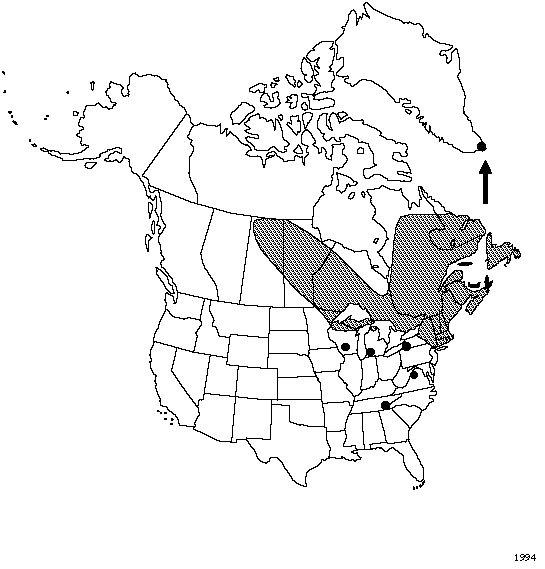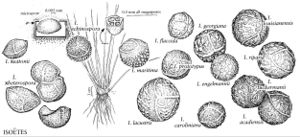Difference between revisions of "Isoëtes lacustris"
Sp. Pl. 2: 1100. 1753.
imported>Volume Importer |
GeoffLevin (talk | contribs) m (Fixed Nfld. and Labr. distribution to match printed version.) |
||
| (One intermediate revision by one other user not shown) | |||
| Line 30: | Line 30: | ||
|phenology=Spores mature late summer. | |phenology=Spores mature late summer. | ||
|habitat=Cool, oligotrophic, slightly acidic lakes and streams | |habitat=Cool, oligotrophic, slightly acidic lakes and streams | ||
| − | |distribution=Greenland;Man.;N.B.;Nfld. and Labr. | + | |distribution=Greenland;Man.;N.B.;Nfld. and Labr.;N.S.;Ont.;P.E.I.;Que.;Sask.;Conn.;Maine;Mass.;Mich.;Minn.;N.H.;N.Y.;R.I.;Tenn.;Vt.;Va.;Wis.;n;c Europe. |
|discussion=<p>Population of <i>Isoëtes lacustris</i> in Tennessee and Virginia are disjunct.</p><!-- | |discussion=<p>Population of <i>Isoëtes lacustris</i> in Tennessee and Virginia are disjunct.</p><!-- | ||
--><p>North American plants of <i>Isoëtes lacustris</i> have been segregated as I. macrospora; both taxa are decaploids (2n = 110) and have similar leaf and spore morphology. Then cannot reliably be distinguished from each other except on the basis of geography.</p><!-- | --><p>North American plants of <i>Isoëtes lacustris</i> have been segregated as I. macrospora; both taxa are decaploids (2n = 110) and have similar leaf and spore morphology. Then cannot reliably be distinguished from each other except on the basis of geography.</p><!-- | ||
| Line 51: | Line 51: | ||
|phenology=Spores mature late summer. | |phenology=Spores mature late summer. | ||
|habitat=Cool, oligotrophic, slightly acidic lakes and streams | |habitat=Cool, oligotrophic, slightly acidic lakes and streams | ||
| − | |distribution=Greenland;Man.;N.B.;Nfld. and Labr. | + | |distribution=Greenland;Man.;N.B.;Nfld. and Labr.;N.S.;Ont.;P.E.I.;Que.;Sask.;Conn.;Maine;Mass.;Mich.;Minn.;N.H.;N.Y.;R.I.;Tenn.;Vt.;Va.;Wis.;n;c Europe. |
|reference=None | |reference=None | ||
|publication title=Sp. Pl. | |publication title=Sp. Pl. | ||
|publication year=1753 | |publication year=1753 | ||
|special status= | |special status= | ||
| − | |source xml=https:// | + | |source xml=https://bitbucket.org/aafc-mbb/fna-data-curation/src/2e0870ddd59836b60bcf96646a41e87ea5a5943a/coarse_grained_fna_xml/V2/V2_398.xml |
|genus=Isoëtes | |genus=Isoëtes | ||
|species=Isoëtes lacustris | |species=Isoëtes lacustris | ||
Latest revision as of 22:32, 20 February 2024
Plants aquatic, submerged. Rootstock nearly globose, 2-lobed. Leaves evergreen, dark green to reddish green, pala brown toward base, spirally arranged, to 25 cm, rigid, abruptly tapering to tip. Velum covering less than 1/2 of sporangium. Sporangium wall ± brown-streaked. Megaspores white, 55–750 μm diam., cristate to reticulate with branching to anastomosing ridges; girdle densely papillate or rarely smooth. Microspores gray in mass, 33–45 μm, paillose. 2n = 110.
Phenology: Spores mature late summer.
Habitat: Cool, oligotrophic, slightly acidic lakes and streams
Distribution

Greenland, Man., N.B., Nfld. and Labr., N.S., Ont., P.E.I., Que., Sask., Conn., Maine, Mass., Mich., Minn., N.H., N.Y., R.I., Tenn., Vt., Va., Wis., n, c Europe.
Discussion
Population of Isoëtes lacustris in Tennessee and Virginia are disjunct.
North American plants of Isoëtes lacustris have been segregated as I. macrospora; both taxa are decaploids (2n = 110) and have similar leaf and spore morphology. Then cannot reliably be distinguished from each other except on the basis of geography.
Isoëtes lacustris is a totally submerged aquatic. Plants have been found at depths of more than 3 m. Plants with rugulate megaspores bearing smooth, rounded ridges and a smooth girdle have been called I. hieroglyphica A. A. Eaton [I. macrospora f. hieroglyphica (A. A. Eaton) N. E. Pfeiffer].
Isoëtes lacustris hibridizes with I. echinospora [ = I. x hickeyi W. C. Taylor & Luebke]; I. engelmannii; I. riparia [ = I. x jeffreyi D. M. Britton & Brunton]; and with I. tuckermanii [ = I. x harveyi A. A. Eaton].
Selected References
None.
